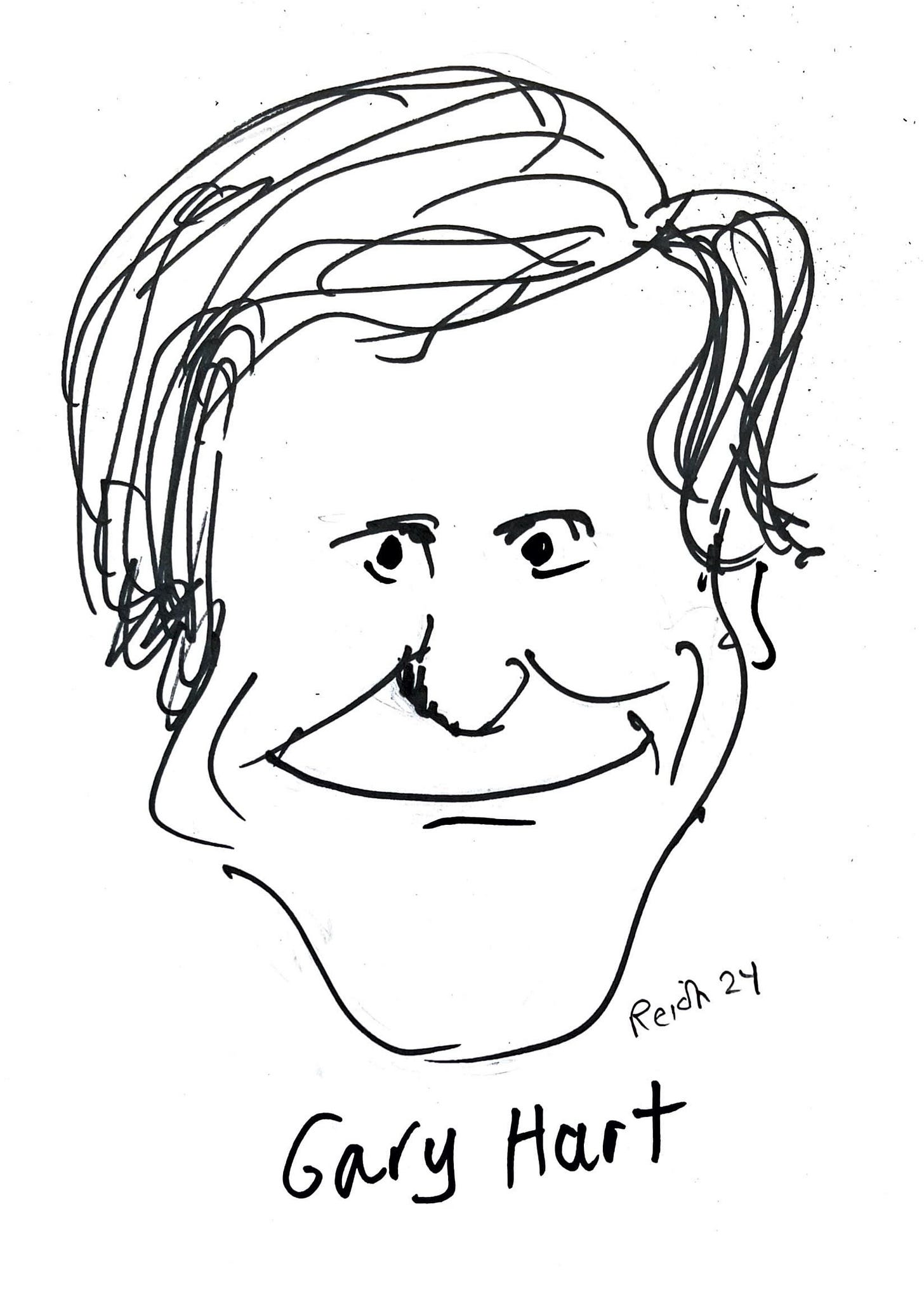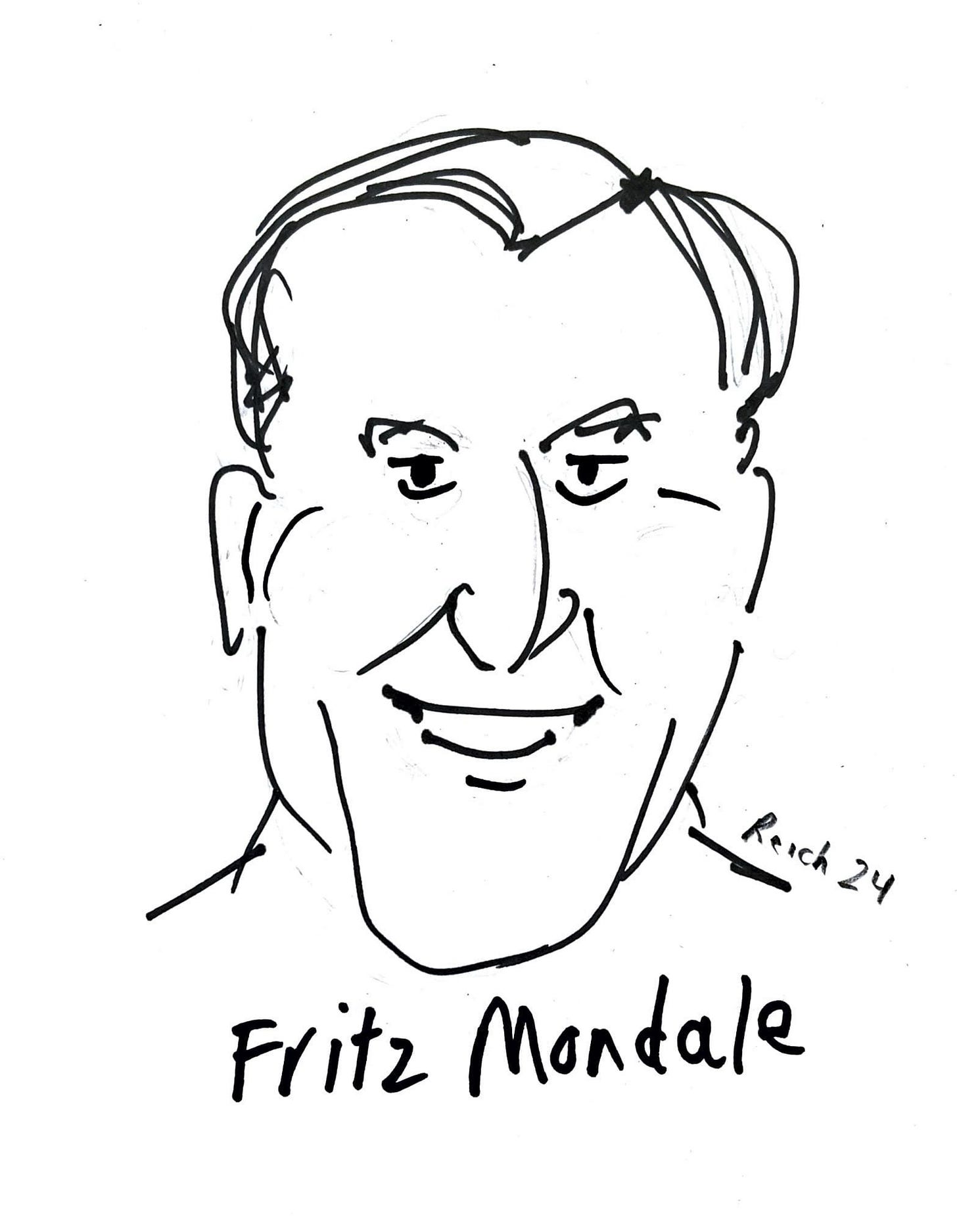Biden's strong State of the Union — and my utter failure advising Democratic presidential candidates
My advice was worth exactly what they paid for it — nothing.
Friends,
Yesterday, I shared with you the advice I gave President Biden on what he should say in his State of the Union address.
He didn’t quite take it, but I thought his address was excellent. He said what needed to be said. He showed grit and forcefulness. He established a sharp contrast with his “predecessor” Trump, whom he called the candidate of humankind’s oldest, most primitive instincts, “hate, anger, and retribution.”
He lauded unions and praised Sean Fain, president of the United Auto Workers. He called for a higher minimum wage. And after noting that America’s thousand billionaires pay an average of tax rate of only 8.2 percent on their yearly income, he called for imposing a minimum tax on them of 25 percent, and raising the corporate minimum tax to 21 percent.
I’d give him an A for content, and A for feistiness, and an A for energy.
Over the years, my advice to presidential candidates has usually fallen on deaf ears. Or my candidates have lost.
It all began after my book The Next American Frontier came out in 1983. The publisher went into overdrive to market it. Newsweek magazine even did a feature on me, headlined “the Democrats’ New Guru.”
The hype did not endear me to more genuine and experienced Democratic advisers, nor to my Harvard faculty colleagues. But like many such stories, it functioned as a self-fulfilling prophecy. For a time, I did become the Democrats’ new guru.
It wasn’t difficult. Ronald Reagan was then in the White House, Republicans had taken control of the Senate, and the Democratic majority in the House was shrinking. Democrats were on the defensive and desperate for new ideas.
I had a lot of them, but my ideas didn’t help. My Democratic advisees repeatedly lost in the 1980s.
The first to seek me out was Gary Hart, a young and telegenic senator from Colorado who was eyeing the 1984 presidential race. Hart described himself as an “Atari Democrat,” evoking the transition of the economy from industrialized manufacturing to the information age.
Hart was part of a cohort of “New Democrat” politicians — including California Governor Jerry Brown, Senator Tim Wirth of Colorado, Congressman Paul Tsongas of Massachusetts, Arkansas Governor Bill Clinton, and Massachusetts Governor Michael Dukakis — who attracted the support of white suburban professionals by promoting liberal stances on foreign policy, civil rights, feminism, and the environment, while also celebrating entrepreneurship and private-sector growth.
But in their eagerness to distance themselves from the “old Democratic politics” of the New Deal, Hart and other New Democrats left out one important challenge: how to bring the working class into the new economy. Since before 1980, the wages of blue collar workers had stagnated.
I urged Hart to include workers as part of a new industrial policy and help them get additional skills through “lifelong learning,” such as community colleges offering technical skills needed by emerging industries.
But Hart wanted America to move to the new economy as quickly as possible, not spend money on workers in the old one.
Some months later, former Vice President Walter Mondale, also running for president, reportedly exclaimed that my book “will do it for the Democrats!” (this story, too, must have been seeded by my publisher).
He phoned to ask if I would visit him in Minneapolis.
I was flattered, of course, and hopped on the next available flight.
Mondale met me at his home with a warm handshake and a big smile. We sat in his study. He was filled with energy and enthusiasm. He wanted to know everything — how best to rebut Reaganomics, what a new industrial policy might look like, which public investments had the biggest payoff, what I meant by “lifelong learning,” and on and on.
His questions continued at a fast pace. He wrote everything down. Two of his campaign advisers joined us. After several hours I was exhausted, but he was just starting.
I told him that a deepening rift in American politics had begun, related to a change in the structure of the economy — from industrialized manufacturing to the information age, from standardized high-volume production to high-value production, from routine assembly-line jobs to knowledge-intensive jobs.
American workers needed help making this shift. I went further than I went with Hart, urging Mondale to advocate more generous safety nets to protect workers when they lost their jobs, such as turning the unemployment compensation system into a re-employment system for workers who had lost their jobs in industries that were shrinking, and presumably would need help getting new ones.
And requiring big corporations to devote at least 2 percent of their net profits to giving their workers higher skills.
I suggested that big corporations scaling back production or abandoning their communities should be required to give notice of their plans at least six months beforehand so their workers and communities had a bit of time to adjust, and requiring these corporations help fund the transition of these workers and communities to attract new industries and technologies.
Otherwise, I said, the working class would be abandoned.
But Mondale wasn’t particularly interested in smoothing the way to a new economy. He wanted to preserve the old one.
The irony wasn’t lost on me: Here we were in the Orwellian year of 1984, and one leading Democratic candidate wanted to rush into the new economy even at the cost of abandoning most workers trapped in the old one, while the other leading Democrat wanted to preserve the old economy even at the cost of slowing America’s move into the new one.
The national AFL-CIO endorsed Mondale even before the first 1984 Democratic primary. In the all-important New Hampshire primary, Mondale lost to Hart, but he went on to win the Democratic nomination.
Mondale then lost to Reagan in a landslide.
***
Four years later, Michael Dukakis was running for president. Dukakis took policy seriously, which the media never quite understood. He was politically odd in other ways — short, serious, kind, cerebral, and high-minded. He spoke in quick bullet-like bursts.
I got to know Mike (he insisted on being called Mike) from long conversations in his governor’s office on Beacon Hill and in Harvard’s Kennedy School, where he occasionally lectured.
As governor, he had presided over what many called the “Massachusetts miracle” — an economic renaissance in what had been a rather backwater state. By 1985, Massachusetts had the highest average per capita income and highest percentage of service-sector workers of any state in the nation.
The engines of that miracle were Harvard and MIT — and the Department of Defense, which financed much of their high-tech research. The added ingredients were entrepreneurs who applied the research to a slew of innovations — forming a ring of high-tech companies around metropolitan Boston in an efflorescence of office parks and labs.
Much the same was unfolding in the Bay Area, in North Carolina’s “research triangle,” and in Atlanta — wherever there were research universities, financial hubs, and international airports.
Suburban knowledge workers — engineers, tech executives, scientists, lawyers, academics, and financiers — were replacing manufacturing workers to become the fastest growing occupational sector in “post-industrial society,” as Harvard sociologist Daniel Bell famously labeled the post–World War II economy.
And because they contributed bundles of money to Democratic campaigns, voted in large numbers, and (like me) engaged in issue-based advocacy that received outsized media attention, such knowledge workers began to exert disproportionate influence over the Democratic Party, eclipsing labor unions and workers from the party’s old industrial base.
As governor, Mike brokered deals between high-tech companies and Boston-based venture capital firms, leading to a surge of new software, data processing, and computer manufacturing corporations.
In 1988, he rode the high-tech growth wave into the Democratic presidential primaries, making the “Massachusetts miracle” the centerpiece of his campaign. (Hart tried again but was blown off course by Monkey Business.)
Mike sought my policy advice, as well as that of Larry Summers.
I again pushed for an industrial policy to ease the adjustment of all workers into the new economy. Larry wanted to reduce the federal budget deficit, promote savings and investment, and retard consumption.
The Washington Post’s Hobart Rowan wrote that Dukakis’s “two key economic advisers are engaged in a bitter battle” for Dukakis’s heart and mind. “It would be disturbing,” Rowan continued, “if the public saw confusion and disarray on what the basic economic policy of a Dukakis administration would be.”
Rowan’s reporting did not exactly help Dukakis’s campaign. But it was not a bitter battle. Larry and I disagreed in private but didn’t air our disagreements publicly.
I told Rowan that some 60 percent of the nation’s problems could be solved by traditional macroeconomic remedies. “That leaves 40 percent, an awful lot, for micro approaches — on investment, training, trade policy” and industrial policy — and that Dukakis’s success in helping make Massachusetts a center for the industries of the future proved this.
Larry also played down our differences, saying “the direction of Reich’s thinking as I have gotten to know him” was the same as “the direction the policies of the state of Massachusetts has taken, and so far as I know, that’s the orientation of the governor.”
Our policy advice had no effect on the election, in any event.
The trouble started when one of Mike’s rivals in the crowded Democratic field, Senator Al Gore from Tennessee, mentioned in a primary debate that Mike had supported furloughs for prisoners, including murderers (a charge that, as we’ll see, George H.W. Bush used effectively in the general election).
This led Mike to publicly urge his rivals to wage positive campaigns rather than throw dirt at each other.
Then Mike’s key campaign aide — a brilliant young political operative named John Sasso — gave reporters a video showing that another of Mike’s primary opponents, Delaware Senator Joe Biden, had quoted liberally without attribution from a British politician’s speech. This and other disclosures forced Biden out of the presidential race.
High-minded Mike promptly fired Sasso, thereby losing his most important political adviser.
Mike won the Democratic nomination but lost after a brutally negative presidential campaign waged by George H.W. Bush, including the infamous Willie Horton ad.
The ad featured a photo of a disheveled Black man who had been given a weekend furlough from a Massachusetts prison, accompanied by a voice stating that Dukakis “allowed first-degree murderers to have weekend passes from prison. One was Willie Horton, who murdered a boy in a robbery, stabbing him 19 times. Despite a life sentence, Horton received 10 weekend passes from prison. Horton fled, kidnapped a young couple, stabbing the man and repeatedly raping his girlfriend. Weekend prison passes — Dukakis on crime.”
The ad was the brainchild of Republican political strategist Lee Atwater, who claimed that “by the end of the campaign, you’re going to think that Willie Horton is Michael Dukakis’ running mate.”
It was a bogus charge. At the time, all 50 states had furlough programs for prisoners, including for murderers in many states. Even Ronald Reagan, when governor of California, had a furlough program. But the charge stuck.
Worse, the ad stifled criminal justice reform for a generation and taught Democrats they needed to be tough on crime — ending furlough programs, imposing longer sentences, and removing educational opportunities for inmates.
It led to Bill Clinton’s 1994 crime act, which included nearly $10 billion for building more prisons and 100,000 more cops on the streets and took away Pell education grants for prison inmates. The law was drafted by Delaware Senator Joe Biden.
Perhaps even worse for Mike was a video of him driving an army tank in a helmet that seemed three times too large for his head. He had gone to the tank factory to show his support for conventional weapons, but Bush used the image to ridicule Mike and describe him as soft on defense.
My candidates had repeatedly struck out. I assumed my days as a policy adviser to aspiring presidents were over.
But then the Democratic Leadership Council — which claimed to represent America’s future of high-tech and suburban professionalism, in contrast to what it described as America’s past of blue-collar workers and labor unions — proclaimed Bill Clinton its leader.






The Republicans showed us last night who they are. Mike Johnson’s reactions were despicable! They are definitely in the Trump cult! Trump told them to shake their heads left and right to everything President Biden says. They should be ashamed but , as we all saw last night, they have no shame!They make me sick to my stomach!
Trump’s “CULT 45” base members are easily found and easily identified because they all bye and wear his MAGA merchandise! Which is a sign that the economy is doing better.
MAGA, (Making Americans Gullible Airheads), has worked for Trump and his Congressional Lapdogs. His base supporters believe every gaslighting thing he says. I used to feel empathy for his supporters. However, I no longer do because they have access to enough resources that provide facts, based on data, and refuse to believe them!
I just hope that there are enough Americans who see through Trump, like the clean air after a thunderstorm, this coming November.
…….Trump is America’s “FOOLS GOLD”…….
joe biden -- as the kids these days say -- TOTALLY SLAYED the state of the union ... at one point, if you were strictly reading the speech (rather than watching or listening to it), it very well could have been a speech delivered by bernie sanders ... mind ... BLOWN !!!
the key question is : who saw this speech ??? ... who saw that, though he has trouble speaking at times, we all saw a man with vigor, energy and incredibly sharp wit ...
did young people watch it ??? ... did black and brown voters watch it ??? ... did suburban housewives watch it ??? ... did the people who NEED to see THIS joe biden watch it ???
to those of US who watched it, we saw what the entire country needs to see ... he SCHOOLED the republicans -- particularly on immigration and the border policy (" we can talk about fixing the border, or WE CAN FIX IT") ... he completely excoriated the despicable supreme court TO THEIR FACES (though three of them were conspicuously absent from attendance -- which was in no way a surprise) ...
joe biden more than rose to the occasion last nite, leaving absolutely NO QUESTION to any human with a brain who we need to vote for this november ...
the problem, & the key question, is : did the people who NEED to see it watch it, and HOW do we get this message across ???